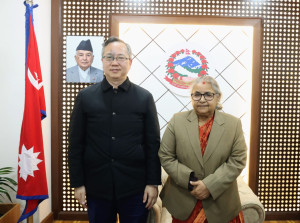National
Constitutional Bench to hear all the petitions against House dissolution
As many as 30 petitions, including one by the opposition alliance, have been filed.
Post Report
Chief Justice Cholendra Shumsher Rana has decided to send all petitions related to the Constitutional Bench for hearing.
As many as 30 petitions, including one by the opposition alliance, have been filed at the Supreme Court, challenging Friday’s House dissolution.
After a preliminary hearing on 19 petitions, Rana decided to send them all to the Constitutional Bench.
“A single bench of Chief Justice Rana has decided to send all the petitions related to the House dissolution to the Constitutional Bench,” Kishor Poudel, a communication expert at the Supreme Court, told the Post. “Hearing of the 19 petitions will be conducted by the Constitutional Bench along with 11 other petitions that were directly filed to the bench.”
Eleven other petitions were directly registered at the Constitutional Bench.
Some of the petitioners had demanded an interim against the dissolution and calling of the House meeting to present the national budget. Rana, however, refused. As per the constitutional provision, the government must present the federal budget at the federal parliament on Jestha 15, which is May 29 Friday this year.
Since there is no Parliament, the government is planning to bring the budget through an ordinance.
According to court officials, the Constitutional Bench will start hearing from Friday.
The constitution envisions a five-member Constitutional Bench which is led by Chief Justice Rana. The members of the bench are selected by Rana.
President Bidya Devi Bhandari late on Friday night dissolved the Parliament on the recommendation of Prime Minister KP Sharma Oli. Earlier on Friday evening, Bhandari rejected the claims of both Oli and Deuba for the prime ministerial post, saying the “claims were insufficient.”
The President has called snap polls on November 12 and 19.
This is the second time in five months Oli and Bhandari dissolved the House.
Earlier on December 20, the President dissolved the Parliament and called snap polls on April 30 and May 10. However, two months later, the Rana-led Constitutional Bench on February 23 overturned the decision and reinstated the House.
The fresh dissolution follows a series of actions by Oli.
After rendering the House, whose first meeting was held on March 7 after it was restored by the court, dysfunctional for two months, Oli on May 10 went for a floor test. He failed. But on May 13 he was appointed prime minister again under Article 76 (3) after opposition parties failed to prove a majority to form a new government under Article 76 (2).
But instead of making a bid to secure the confidence of the House, as mandated by the constitution, Oli on May 20 prodded the President to invoke Article 76 (5), a move that constitutional experts say is unconstitutional and illegitimate.
Oli argued that there was no political ground for him to secure a vote of confidence in the House.
Bhandari gave until 5pm of May 21 to form a new government under Article 76 (5). Congress President Deuba laid claim to a new government with the signatures of 149 lawmakers. But Oli again made a claim, saying he had the backing of 153 lawmakers. He did not provide signatures of the lawmakers.
The President disqualified both the claims.
On Monday, as many as 146 members of the dissolved House jointly filed a petition arguing that the House dissolution was unconstitutional and the President bulldozed the constitution by rejecting Congress President Deuba’s claim as the prime minister.
The petition has signatures 61 members from the Nepali Congress, 49 from the Communist Party of Nepal (Maoist Centre), 23 from the Madhav Nepal faction of the CPN-UML and 12 from the Upendra Yadav-Baburam Bhattarai faction of the Janata Samajbadi Party. The only member from Janamorcha Nepal who was in the House has also signed the petition.




 7.12°C Kathmandu
7.12°C Kathmandu













